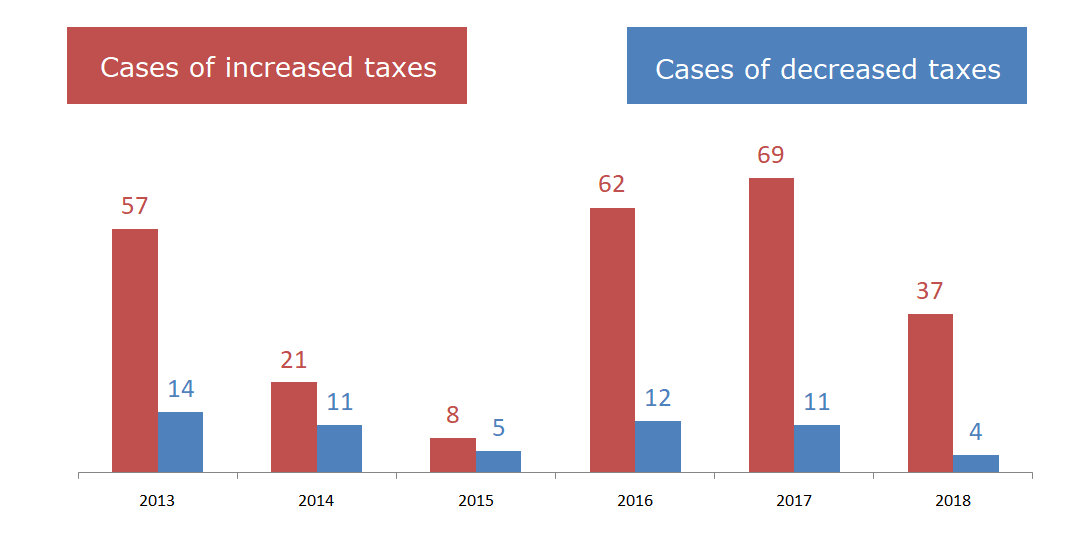Which Municipalities Register the Highest Increase and the Largest Decrease in the Number of People Employed
The improving the economy has not had any positive effect on the labor market in many of the poorer municipalities, especially those in which there are persistent negative demographic trends.
After we presented two weeks ago the data for the size of the average gross wage on municipal level, our analysis of the labour market continues with a review of the dynamics of the number of employed people. Since the differences in the number of workers on municipality level are considerable and depend highly on the size of the local population, the map below shows the relative change in the number of workers in 2017 compared to 2011. This approach to the presentation of data also implies certain conditionality and because of this our analysis focuses its attention only to municipalities in which lasting trends are observed, regardless of their demographic developments.
It is important to note that the data presented on the map show the workers based on their place of work and not on their domicile. Because of this, for example, it is not surprising that in the municipalities around Plovdiv, where most of the newly founded industrial zones are situated, register a higher relative growth of employees in the local centre.
Compared to 2011, the total number of employed people in the country in 2017 has increased by 2.9%. On the municipal level the situation is the following:
- 78 municipalities register an increase larger than the average for the country: from the district centres here we can find the capital, Plovdiv, Sliven, Targovishte, and Kardzhali;
- 29 municipalities register an increase, despite being lower than the average for the country; from the district centres here we can find Montana, Pazardzhik, Yambol, Razgrad, Varna and Burgas;
- in the remaining 155 municipalities the number of workers has declined; moreover, in 57 of them the decline is more than 10%. From the district centres here we can find Lovech and Dobrich;
The good examples
The municipality of Letnitsa in the Lovech district has experienced the highest increase in the number of employed people compared to 2011, which has also been accompanied by a significant growth in the payment of the already hired 1500 people in the same municipality. The average gross wage in the municipality has increased by 56%, reaching 1,425 leva, which is 18% more than the average for the country. One of the main factors behind the good performance of the municipality of Letnitsa is the presence of “Walltopia Ltd”, but companies from the ceramic and food industries also operate in the municipality.
In second place in terms of increase in the number of workers is the municipality of Bozhurishte (with an increase of 62% ) where the average wage of the 2500 employed people there is nearly 1,150 leva in 2017, exceeding by 10% the average levels for the country. Near the capital, apart from Bozhurishte, a considerable increase in the number of employed people (with around 1/3) has also the municipality of Botevgrad where the daily employed increase with around 500 people, reaching 12,600. This positive trend has not stopped since 2012 and is accompanied with an increase in the wages which is higher than the average for the country. Moreover, since 2017 the level of pay in the municipality is above the average for the country. In 2017 there was also an increase in the number of workers in the municipality of Mezdra (with around 1900 people), mainly because of the production of auto parts. The wages in the region, however, remain low and the unemployment level is considerably high.
The success of the “Trakia” economic zone is clearly seen on this map as well. The municipalities around Plovdiv have some of the best results in the country – in 2017 in the municipality of Rodopi the increase in the number of employed people is 48% compared to 2011, 39% in the municipality of Saedinenie, 28% in the municipality of Rakovski, 23% in the municipality of Kuklen, and 15% in the municipality of Maritsa. In each of these municipalities, with the exception of Kuklen, the level of pay is increasing quicker than the average for the country as the average wage in the municipality of Maritsa, where the most people work (if we exclude Plovdiv itself), is already 1% above the average for the country.
With over 50% is increasing the relative share of the employees in the municipalities of Aksakovo and Suvorovo (Varna region). In Aksakovo there is a lasting trend toward an increase, as the interest for investing in the region continues to be significant. In the meantime, the result from the smaller local labour market in Suvorovo can be mainly attributed to the one-time expansion in 2012, followed by a period of stagnation in the number of employed people.
The municipalities in the “red” zone
The negative demographic development of a significant part of the Bulgarian municipalities has a profound effect on their potential to reach an increase in the number of employed people on their territory. In the same time, like in the case of successful municipalities, this effect can be softened or strengthened depending on the condition of the local economy.
The highest decline in the number of employed people is observed in the municipality of Miziya, in the district of Pleven (a decline of 40%), as well as in the municipalities of Bobov dol and Trun (with 33,8%). It is important to note that in this case we are talking about a municipality which ran a referendum against the development of heavy industry, and a municipality in which companies have serious problems in the same sector which in turn leads to the closing of mines and to job cuts.
Nearly 1400 out of the 1700 total jobs in the municipality of Bobov dol disappeared during 2016 and 2017 which is related to the crisis in the coal mining sector – the closing of the “Babino” mine and the cuts in the “Fundamental” mine (later closed in 2018). The “bottom” in the labour market in the municipality of Tran was reached relatively late – in 2015, whereas the subsequent increase in the number of employed people was rather small and we could hardly talk about a real recovery. In the same time in Tran, and in other relatively small communes like the already mentioned Miziya, Georgi Damyanovo, Bregovo, Brusartsi, etc., wages are increasing faster than the average for the country, mostly because of the immediate effect from the increase in the minimum wage.
Despite this, in all these municipalities, the average gross wage remains lower than 65% of the average for the country as in most municipalities the “catching up” is only a couple of percentage points, and as we already mentioned, the employed people decline drastically.
Highly worrying is the situation in Bolyarovo (Yambol region), where the decline in the number of employees of 25% is accompanied by a relative decline in the wages – from 69% to 59% of the average. Keeping in mind the problems in the key for the municipality livestock sector in 2018 (the euthanasia of thousands of small ruminant animals), it can be expected that the situation is even worse. An even more drastic decline in wages, again accompanied by a significant decline in the number of employees, is registered in Bobov dol and Belene – from 109% to 83% from the average for the country and from 97% to 66% from the average for the country, respectfully.
The data for the levels of the gross wages and for the number of employees on the municipal level show that the recovery of the labour market and the subsequent expansion are going on unevenly on the territory of the country. The improvement of the overall economic conjuncture does not seem to have a strong positive effect on the labour market in the very poor municipalities, especially in those in which strongly negative demographic processes are observed. Despite the fact that most of the increases in the number of employed people comes from the South, some of the best performing local labour markets are in the North. As is clear from the map, however, we can hardly talk about a homogenous development in the North-West and the North-Central regions. The impression of a presence of separate “islands” of economic activity is confirmed from these data.
 For the seventh year in a row, the Institute for Market Economics presents the study “Regional profiles: Indicators for Development” – the only comprehensive yearbook on Bulgarian regional development. The Regional profiles, as the study is better known, has become an indisputable trademark of the IME.
For the seventh year in a row, the Institute for Market Economics presents the study “Regional profiles: Indicators for Development” – the only comprehensive yearbook on Bulgarian regional development. The Regional profiles, as the study is better known, has become an indisputable trademark of the IME.

